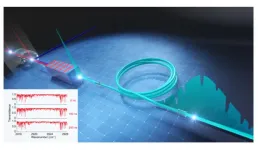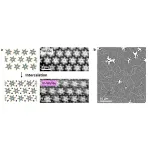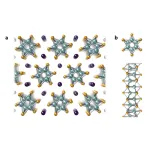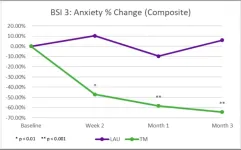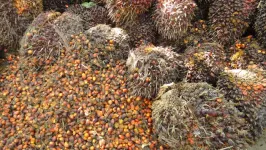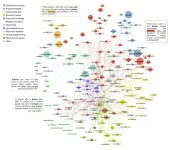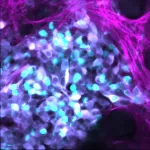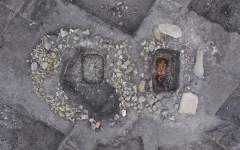(Press-News.org) Infrared spectroscopy is a non-invasive tool to identify unknown samples and known chemical substances. It is based on how different molecules interact with infrared light. You may have seen this tool at airports, where they screen for illicit drugs. The technique has many applications: liquid biopsy, environmental gas monitoring, contaminant detection, forensic analyses, exoplanet search, etc. But the traditional infrared spectroscopy methods provide low (temporal) resolution data. They are usually only applied for static samples because spectral data acquisition is a slow process. Detecting fast-changing phenomena requires multiple quick measurements. Thanks to Prof. Ideguchi and his team at the University of Tokyo, it is now possible to obtain high-speed and high-resolution spectral data. The team discovered the upconversion time-stretch infrared spectroscopy (UC-TSIR) that can measure infrared spectra with 1000 spectral elements at a rate of 10 million spectra per second.
Atoms in a molecule are bound together—like spheres with stiff springs connecting them. Shine infrared light (2-20 µm wavelength) on the substance; it absorbs infrared energy, and the “springs” vibrate. The range of vibrational motions depends on the structure of the molecule. So, we can identify and infer the properties of the substance by detecting the range of wavelengths absorbed by the substance—its absorption spectra.
“With recent improvements in the capability of analyzing spectra using machine learning and other techniques, it is essential for infrared spectroscopy methods to acquire a large amount of molecular vibration information rapidly. We wanted to develop the infrared spectroscopy method to achieve that,” said Prof. Ideguchi, explaining the motivation of the research team.
Conventional time-stretch infrared spectroscopy data has fewer measurable spectral elements (~30) because the instruments work in the infrared region, where optical technology is currently limited. “UC-TSIR breaks the limit by converting infrared pulses containing molecular vibration information into near-infrared pulses with wavelength conversion techniques (upconversion) and temporally stretching and detecting the pulses in the near-infrared region,” said Dr. Hashimoto. Compared to conventional methods, UC-TSIR provides over 30-fold more spectral elements and 400 times better spectral resolution. The UC-TSIR can trace high-speed phenomena such as the combustion of gaseous molecules and irreversible chemical reactions of biomolecules at a high temporal resolution.
In theory, the concept sounds simple and easy to implement; but it was far from that. “We carefully selected optical elements and adjusted the parameters through trial and error. Even after building the setup, we dealt with various spectral distortions caused by unwanted nonlinear optical effects and insufficient time stretching. We were overjoyed when we finally saw clear infrared absorption spectra after dealing with those issues,” said Dr. Hashimoto. “Nanosecond- or microsecond-scale ultra-fast continuous infrared spectral measurements by UC-TSIR can solve problems unresolved by conventional spectroscopy methods.”
###
Related links
School of Science, The University of Tokyo: http://www.s.u-tokyo.ac.jp/en/
Ideguchi lab: https://takuroideguchi.jimdo.com/
END
Detecting the molecular vibration information faster and better by “stretching” time
This ultrafast infrared spectroscopy method would fulfill many unmet needs in experimental molecular science, revealing various high-speed phenomena in detail
2023-03-04
ELSE PRESS RELEASES FROM THIS DATE:
Scientists thread rows of metal atoms into nanofiber bundles
2023-03-04
Tokyo, Japan – Researchers from Tokyo Metropolitan University have successfully threaded atoms of indium metal in between individual fibers in bundles of transition metal chalcogenide nanofibers. By steeping the bundles in indium gas, rows of atoms were able to make their way in between the fibers to create a unique nanostructure via intercalation. Through simulations and resistivity measurements, individual bundles were shown to have metallic properties, paving the way for application as flexible nanowires in nanocircuitry.
Atomic wires of transition metal chalcogenides (TMCs) ...
Intellifoods Labs, LLC strengthens partnership with Mason scientists to reduce food bacterial contamination detection time
2023-03-03
Mason Associate Professor of Infectious Diseases and Microbiology, Ramin M. Hakami has received a total of $35,000 in grants from Intellifoods Labs, LLC to continue examining methods to reduce the time to detect the presence of bacteria in food samples.
Numbers and types of foodborne disease occurrences have increased over time and are a major global public health concern. Hakami and his team seek to reduce the time to identify both live and dead bacteria in food samples using fluorescence detection. The team aims to optimize the detection ...
Transcendental Meditation highly effective in rapidly reducing healthcare worker burnout symptoms during the height of the Covid crisis
2023-03-03
Healthcare providers (HCP) at three Miami hospitals during the height of the Covid crisis, who practiced the Transcendental Meditation technique (TM), showed a rapid and highly significant reduction in stress-related burnout symptoms such as somatization, depression, anxiety, sleep disturbances, and emotional exhaustion, as well as significant improvement in mental well-being, compared to a parallel matched lifestyle-as-usual group (LAU), according to a new study published today in PLOS ONE.
A total of 65 healthcare providers at the three Miami hospitals (Baptist, ...
Unique hybrid reefs deployed off Miami Beach
2023-03-03
The first piece of a series of concrete structures was lowered into the water off the coast of Miami Beach on Wednesday morning, a massive crane on the deck of a floating barge hoisting the unit into the air and sinking it to the seabed.
During the next six hours, crewmembers aboard the barge would repeat that process until the structures, some stacked on top of each other, were settled on the seafloor, 14 feet below the surface.
To casual observers onshore, the daylong operation might have seemed routine. But this maritime activity was hardly run-of-the-mill.
In ...
Scientist to launch interstellar space music
2023-03-03
A scientist from Anglia Ruskin University (ARU) will premiere a new piece of music at the SXSW EDU festival that has been created using data beamed back to Earth from interstellar space.
On Thursday, 9 March, Dr Domenico Vicinanza will be joined on stage in Austin, Texas, by Dr Alyssa Schwartz, Visiting Assistant Professor of Flute and Musicology at Fairmont State University, to perform music shaped by scientific readings collected by NASA’s Voyager 1 spacecraft.
Dr Vicinanza, a Senior Lecturer in ARU’s School of Computing and Information Science, is a leading expert ...
Mechanical weeding promotes ecosystem functions and profit in industrial oil palm
2023-03-03
Oil palm trees are the most productive oil crop and global demand is increasing. However, their productivity is due to conventional management practices including high fertilizer usage and herbicide application, resulting in severe environmental damage. A new study by an international, multidisciplinary research team led by the University of Göttingen, shows that shifting to mechanical weeding and reducing fertilizer usage lead to significant increases in both ecosystem multifunctionality and profit. The scientists compared different environmental measures and economic indicators in mechanical weeding, herbicide application, and combinations of these with high and reduced fertilizer ...
News you can use—to better predict food crisis outbreaks
2023-03-03
A team of researchers has developed a machine learning model that draws from the contents of news articles to effectively predict locations that face risks of food insecurity. The model, which could be used to help prioritize the allocation of emergency food assistance across vulnerable regions, marks an improvement over existing measurements.
“Our approach could drastically improve the prediction of food crisis outbreaks up to 12 months ahead of time using both real-time news streams and a predictive model that is simple to interpret,” says Samuel Fraiberger, a visiting researcher at ...
Tumour cells’ response to chemotherapy is driven by randomness
2023-03-03
Cancer cells have an innate randomness in their ability to respond to chemotherapy, which is another tool in their arsenal of resisting treatment, new research led by the Garvan Institute of Medical Research shows.
Understanding why some tumour cells become resistant to chemotherapy is a core challenge in cancer research, as chemotherapy is still a frontline treatment for most cancers.
The new research shows that tumour cells from neuroblastoma – cancer that develops in the body’s ‘fight or flight’ sympathetic nervous system – can move between states of responding, or not, to chemotherapy.
“We showed there is ‘noise’ in the process of cell ...
On social media platforms, more sharing means less caring about accuracy
2023-03-03
As a social media user, you can be eager to share content. You can also try to judge whether it is true or not. But for many people it is difficult to prioritize both these things at once.
That’s the conclusion of a new experiment led by MIT scholars, which finds that even considering whether or not to share news items on social media reduces people’s ability to tell truths from falsehoods.
The study involved asking people to assess whether various news headlines were accurate. But if participants were first asked whether they would share that content, they were 35 percent worse at telling truths from ...
The world’s first horse riders
2023-03-03
The researchers discovered evidence of horse riding by studying the remains of human skeletons found in burial mounds called kurgans, which were between 4500-5000 years old. The earthen burial mounds belonged to the Yamnaya culture. The Yamnayans had migrated from the Pontic-Caspian steppes to find greener pastures in today´s countries of Romania and Bulgaria up to Hungary and Serbia.
Yamnayans were mobile cattle and sheep herders, now believed to be on horseback.
“Horseback-riding seems to have evolved not long ...
LAST 30 PRESS RELEASES:
Making lighter work of calculating fluid and heat flow
Normalizing blood sugar can halve heart attack risk
Lowering blood sugar cuts heart attack risk in people with prediabetes
Study links genetic variants to risk of blinding eye disease in premature infants
Non-opioid ‘pain sponge’ therapy halts cartilage degeneration and relieves chronic pain
AI can pick up cultural values by mimicking how kids learn
China’s ecological redlines offer fast track to 30 x 30 global conservation goal
Invisible indoor threats: emerging household contaminants and their growing risks to human health
Adding antibody treatment to chemo boosts outcomes for children with rare cancer
Germline pathogenic variants among women without a history of breast cancer
Tanning beds triple melanoma risk, potentially causing broad DNA damage
Unique bond identified as key to viral infection speed
Indoor tanning makes youthful skin much older on a genetic level
Mouse model sheds new light on the causes and potential solutions to human GI problems linked to muscular dystrophy
The Journal of Nuclear Medicine ahead-of-print tip sheet: December 12, 2025
Smarter tools for peering into the microscopic world
Applications open for funding to conduct research in the Kinsey Institute archives
Global measure underestimates the severity of food insecurity
Child survivors of critical illness are missing out on timely follow up care
Risk-based vs annual breast cancer screening / the WISDOM randomized clinical trial
University of Toronto launches Electric Vehicle Innovation Ontario to accelerate advanced EV technologies and build Canada’s innovation advantage
Early relapse predicts poor outcomes in aggressive blood cancer
American College of Lifestyle Medicine applauds two CMS models aligned with lifestyle medicine practice and reimbursement
Clinical trial finds cannabis use not a barrier to quitting nicotine vaping
Supplemental nutrition assistance program policies and food insecurity
Switching immune cells to “night mode” could limit damage after a heart attack, study suggests
URI-based Global RIghts Project report spotlights continued troubling trends in worldwide inhumane treatment
Neutrophils are less aggressive at night, explaining why nighttime heart attacks cause less damage than daytime events
Menopausal hormone therapy may not pose breast cancer risk for women with BRCA mutations
Mobile health tool may improve quality of life for adolescent and young adult breast cancer survivors
[Press-News.org] Detecting the molecular vibration information faster and better by “stretching” timeThis ultrafast infrared spectroscopy method would fulfill many unmet needs in experimental molecular science, revealing various high-speed phenomena in detail
